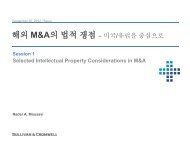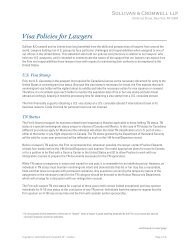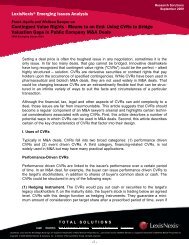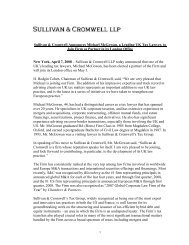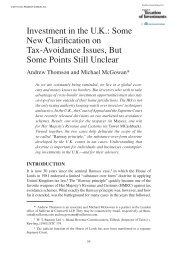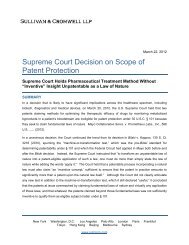CFTC Adopts Internal Business Conduct Rules - Sullivan & Cromwell
CFTC Adopts Internal Business Conduct Rules - Sullivan & Cromwell
CFTC Adopts Internal Business Conduct Rules - Sullivan & Cromwell
You also want an ePaper? Increase the reach of your titles
YUMPU automatically turns print PDFs into web optimized ePapers that Google loves.
As required under Section 4s(j)(7) of the CEA, the Commission has adopted Subpart J of Part 23 of the<br />
regulations in Title 17 of the Code of Federal Regulations (the “CFK Regulations”), 11 as part of the<br />
<strong>Internal</strong> <strong>Business</strong> <strong>Conduct</strong> <strong>Rules</strong>, and that subpart prescribes rules and regulations governing compliance<br />
with the duties enumerated under Section 4s(j) of the CEA.<br />
The <strong>Internal</strong> <strong>Business</strong> <strong>Conduct</strong> <strong>Rules</strong> require an SD or MSP to establish written procedures and policies<br />
with respect to a risk management program. This program, which must be approved by the appropriate<br />
governing body, should monitor and manage the risks associated with swaps activities. In connection<br />
with these policies and procedures, an SD or MSP must establish a risk management unit separate from<br />
its business trading unit with sufficient authority and resources to carry out its requisite duties and<br />
functions. The risk management program of an SD or MSP must take into account and set risk tolerance<br />
limits (and review them quarterly) based on market risk, credit risk, liquidity risk, foreign currency risk,<br />
legal risk, operational risk, settlement risk and any other applicable risks. The <strong>Internal</strong> <strong>Business</strong> <strong>Conduct</strong><br />
<strong>Rules</strong> contain detailed descriptions of these types of risk and describe how the risk management program<br />
should evaluate these risks. The risk management program must also consider risks posed by affiliates. 12<br />
Risk management personnel of an SD or MSP must provide senior management and its governing body<br />
with written reports concerning the risk exposures of the SD or MSP and any changes to its risk<br />
management program and the SD or MSP must furnish this quarterly report to the Commission.<br />
The risk management program of an SD or MSP must include policies and procedures for evaluating the<br />
risks associated with, and approving, new products. These policies and procedures should take into<br />
account whether the new product would materially alter the overall firm-wide risk profile of an SD or MSP.<br />
If the new product would materially alter the risk profile, the governing body must approve the new<br />
product. The new product policy can allow for preliminary approval of a new product at risk levels that are<br />
not material and solely for determining risk management processes for the new product. Under the<br />
<strong>Internal</strong> <strong>Business</strong> <strong>Conduct</strong> <strong>Rules</strong>, the risk management program of an SD or MSP should also include<br />
policies and procedures that relate to its use of central counterparties. The SD or MSP must satisfy all of<br />
the capital and margin requirements established by the Commission or other prudential regulators. In<br />
connection with the risk management program, the <strong>Internal</strong> <strong>Business</strong> <strong>Conduct</strong> <strong>Rules</strong> require that an SD<br />
or MSP establish policies and procedures for its business trading unit that further the objectives of the risk<br />
management program. Moreover, the business trading personnel should be separated from the risk<br />
management personnel.<br />
Pursuant to the <strong>Internal</strong> <strong>Business</strong> <strong>Conduct</strong> <strong>Rules</strong>, an SD or MSP must adopt policies and procedures to<br />
ensure compliance with the position limits established by the Commission, a DCM or an SEF and prevent<br />
improper reliance on exemptions from the position limits. The SD or MSP will be held to a<br />
reasonableness standard in establishing and enforcing policies and procedures to this effect. An SD or<br />
MSP must provide training on position limit compliance to relevant personnel and establish an early<br />
warning system to issue alerts if applicable position limits are in danger of being breached. The <strong>Internal</strong><br />
<strong>CFTC</strong> <strong>Adopts</strong> <strong>Internal</strong> <strong>Business</strong> <strong>Conduct</strong> <strong>Rules</strong><br />
March 8, 2012<br />
-4-




